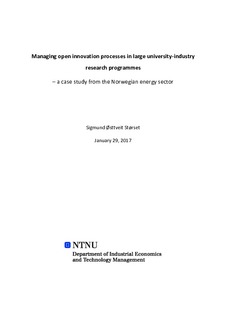| dc.description.abstract | Many companies struggle with developing innovations extending beyond their own knowledge base, and are therefore increasingly relying on external sources of knowledge, as universities or research institutes, for supplementing their innovation processes. One much used collaboration form for supporting this is the research programme, where several universities or research institutes cooperate with several industry companies for promoting technological development and innovation within a specific field of research.
Where several studies have investigated the interplay and processes within university-industry research programmes, few studies have addressed how the research manager can use the position specifically for promoting innovation and innovation processes. The aim of this study is to address this research gap of how research managers can promote innovation in large university-industry research programmes. This has been done following three axes of investigation: Firstly, by investigating how formal organisational structures supported by the research manager can promote a culture for innovation. Secondly, by investigating how relationships between partners influence innovation and how the research manager can affect this. And thirdly, by investigating how the research manager can promote innovation through taking on different leadership roles. The research was done through a case study consisting ofsix large university-industry research programmes from the Norwegian energy sector, based on a qualitative method using semi-structured interviews for data acquisition.
The findings in the study firstly suggest that formal organisational structures built for promoting innovation can serve as means for establishing a culture for innovation given continuous attention and focus from management to the topic over time. The effect of the implemented structures for promoting innovation are indirect, as lack of management focus highly increases the chances for failure of the initiative. Secondly, the findings suggest that engaged relationships between research programme partners can be promoted by high relational involvement and developed cooperation, and that this will contribute towards reducing the friction caused by opposing logics, and promoting innovation and innovative research. The research manager is in a key position to promote such relationships by taking on the role as a bridge builder between partners. Lastly, the findings suggest, as supported by the last statement, that the research manager stands in a pivotal position for promoting innovation in the research programme by taking on different leadership roles as, in addition to the bridge builder, the change maker or the team player leadership roles.
Seven propositions for emerging theory are given, and a new theoretical model is suggested. Implications of the study and future results are discussed. | nb_NO |
